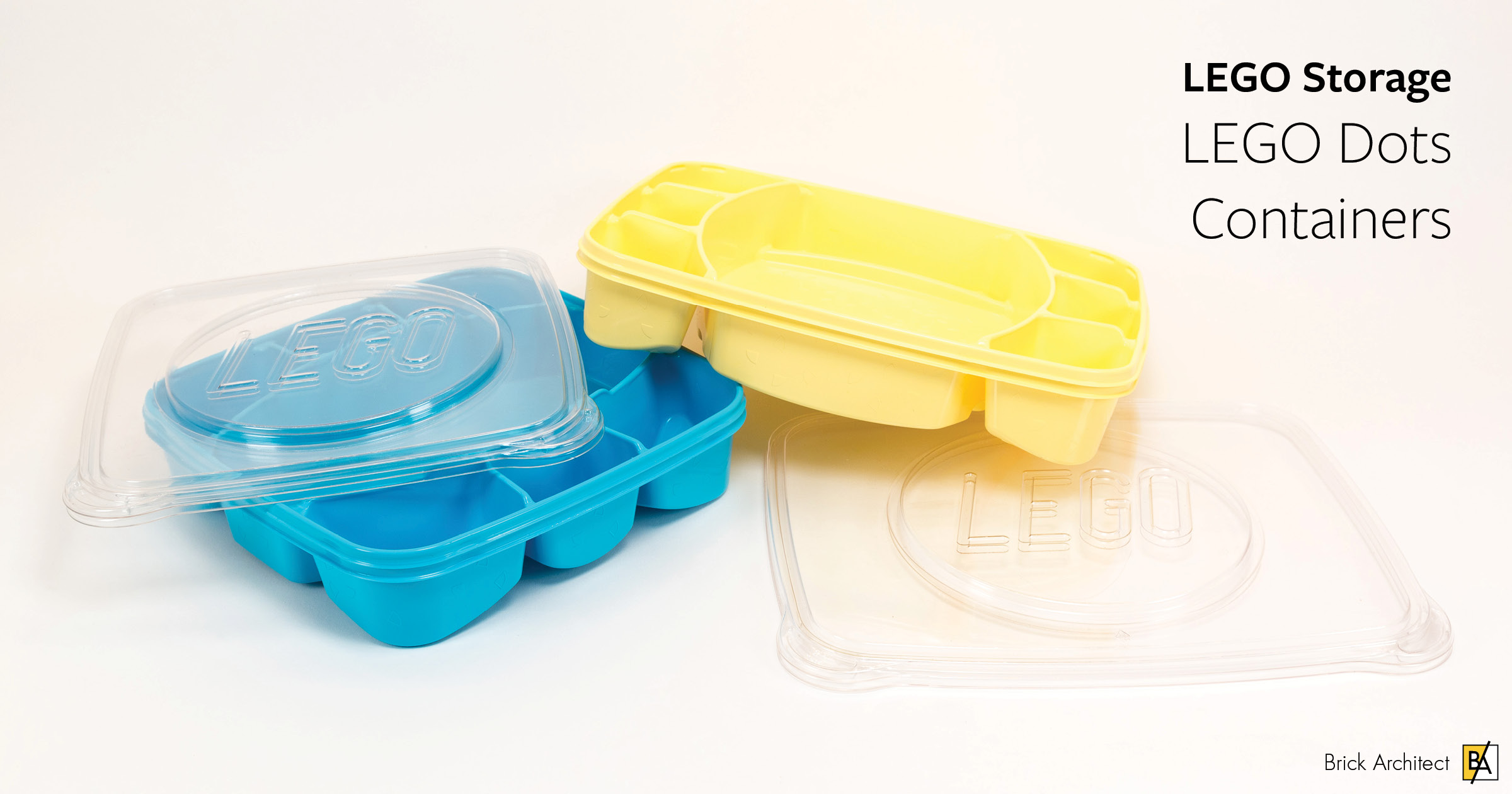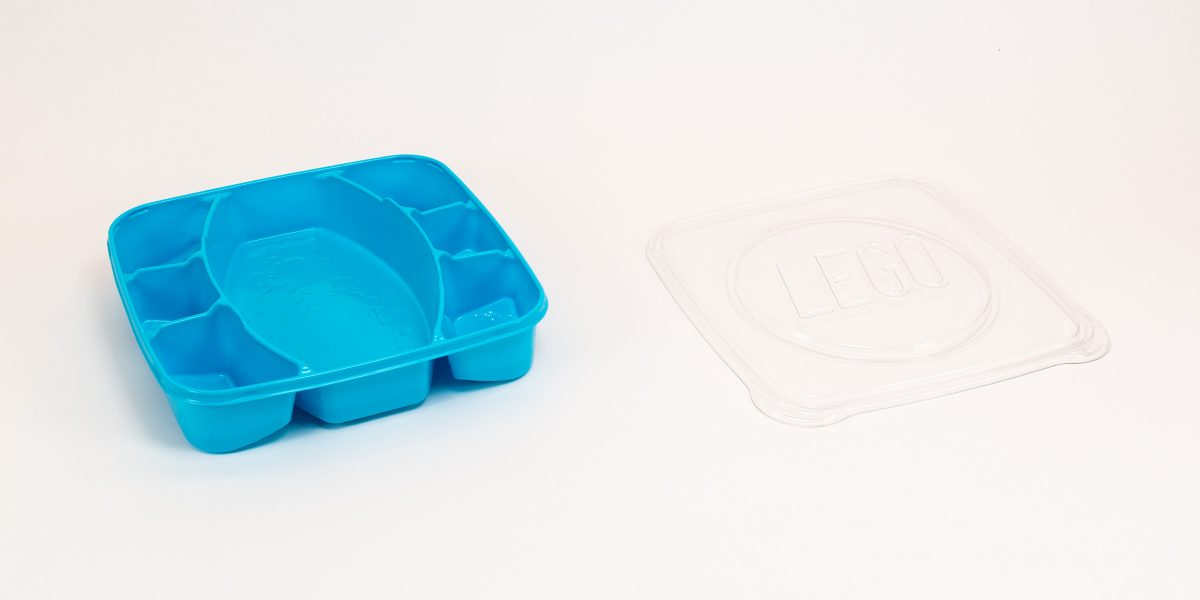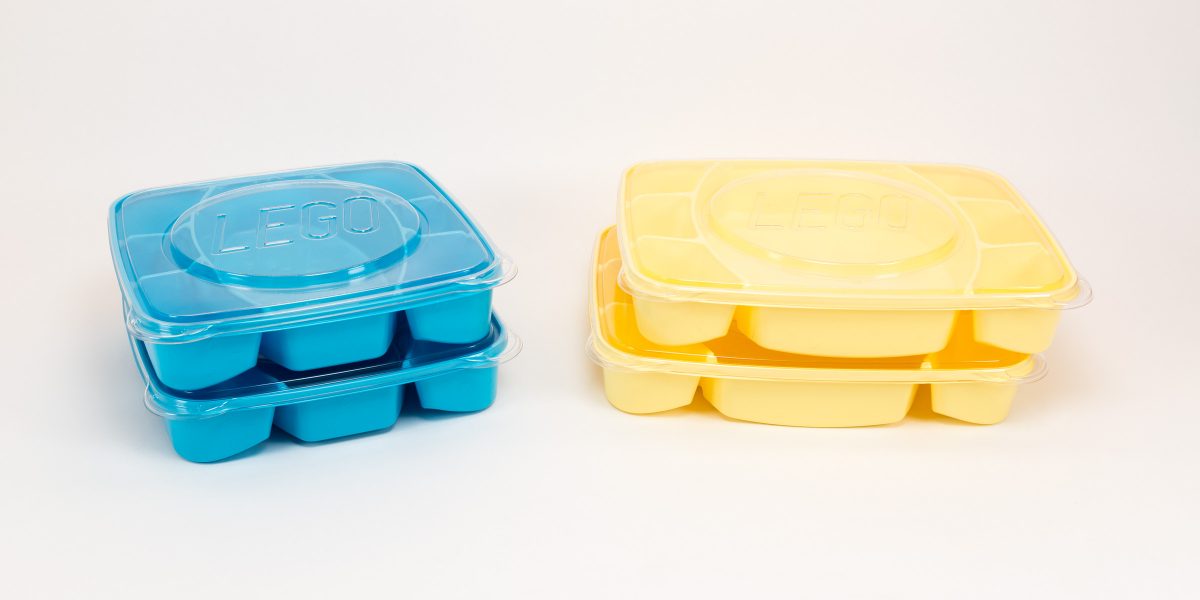Review: LEGO Dots Storage Container
While these containers are “free” with purchase, are they any good for sorting and storing LEGO? Let’s find out by geeking out!
Last month, we reviewed a few sets in new LEGO Dots series. While some of the smaller LEGO Dots sets come in a polybag, all of the larger sets come in either a small or large reuseable plastic container. In this article, we will learn more about those containers, and determine if they will help you organize your LEGO collection.
The LEGO Dots storage containers are made of a thin plastic and include a tight-fitting clear plastic lid. Each container is divided into seven compartments: one large central compartment, and three smaller compartments on either side. The larger of the two containers includes two horizontal ridges in the central compartment which allow you to organize pieces further while building (and help them stack more easily.)
The lids feature an oversized “LEGO” branded stud design. While you might expect that this is strictly a design flourish, it serves a practical function too… The bottom of each container is designed to make the containers stack more easily. There isn’t any clutch power whatsoever, but it’s a nice detail which will make it easier to carry a stack of these containers across the room to your workbench.
Technical Details
Let’s take a closer look at these containers to see how many pieces they can store. Since we’re nerds here, we will calculate the storage volumne for each compartment, as well as the overall storage density so you can compare this storage option with other storage product we’ve reviewed (like Really Useful Scrapbook Drawers, and Papimax StackX Drawers.)
Small LEGO Dots container
The small LEGO Dots container is 322Medium AzurMedium Azure, and comes with sets priced $14.99 (such as #41904 Animal Picture Holders or #41905 Rainbow Jewelry Stand.)
Specifications:
- Without lid: 22.2 cm (8 3/4″) wide. With lid: 22.5 cm (8 7/8″) wide.
- Height: 5.1 cm (2″) tall. Height when stacked: 4.8 cm (1 7/8) tall. (Due to space saved by recessed stud).
- 4x – Small corner compartments. 124 mL (308 1×1 plates).
- 2x – Small side compartments. 75 mL (186 1×1 plates).
- 1x – Large central compartment. 861 mL (2145 1×1 plates).
- 62% Storage Density (Based on stacked size w/ lid).
Unlike the larger container, the small containers are square so the lid can be attached in either orientation.
Large LEGO Dots container
The large LEGO Dots container is 226Cool YellowBright Light Yellow, and comes with sets priced $19.99 (such as #41907 Desk Organizer or #41914 Creative Picture Frames.)
Specifications:
- Without lid: 21.6 cm (8 1/2″) wide. With lid: 21.9 cm (8 5/8″) wide.
- With or without lid: 27.3 cm (10 3/4″) long.
- Height: 5.1 cm (2″) tall. Height when stacked: 4.8 cm (1 7/8) tall. (Due to space saved by recessed stud).
- 4x – Small corner compartments. 111 mL (276 1×1 plates).
- 2x – Small side compartments. 94 mL (234 1×1 plates).
- 1x – Large central compartment. 1233 mL (3069 1×1 plates).
- 65% Storage Density (Based on stacked size w/ lid).
Despite the greater width, the smaller container can be stacked fairly well on top of the larger container. That’s because the fake LEGO-branded Stud on both lids has the same 15.2 cm (5 15/16″) diameter.
Closer Look
Let’s take a closer look to see how well the containers work in everyday use.
Stacking
The smaller containers stack pretty well. When stacked, they will slide about 1 cm laterally before the studded lid hits the ridges on the bottom of the uppermost container. While It’s hard to test with just two containers, I could easily imagine carrying a stack of 8 containers without too much trouble.
The larger containers provide more of a problem when stacked. They have a similar 1 cm of play along the shorter dimension, but can slide about 3 cm along the longer dimension before stopping. This will make it harder to carry a tall stack of these containers around the house (or a crowded LEGO convention).

The containers and lids stack easily when not in use, making them easy to set aside to use as temporary storage.
I should add that you can remove the lids and stack the empty containers very efficiently. The plastic is so thin that each additional tray is about 0.6cm (1/4″) and each additional lid is about 0.4 cm (1/8″). This makes it very easy to store a lot of unused containers in a small space.
Storage Density
With a storage density of 62% for the small container and 65% for the larger container, these containers are more efficient than many other storage options. Naturally, you will need shelving to store these containers, which will decrease the storage density of your colllection considerably.
Further, storage density calculations assume that each compartment is completely full. With one very large compartment and six much smaller compartments, it may be difficult to efficiently utilize the central storage compartment since it is so much larger than the other compartments. (An inelegant but cheap option would be to use ziploc bags to further organize parts in the central compartment.)
Lid Performance
To be honest, I did not expect parts to stay in their compartments due to the thin plastic of the container and lid. I’m happy to report that parts whcih are as big as or larger than a 1×1 plate (part 3024) will stay in their compartments almost all of the time, even when the container is shaken vigorously.
Unfortunately, a few of the smaller 1×1 Tiles (which are the most common pieces in most LEGO Dots sets) do migrate to a different compartment when the container is shaken vigorously. This is easily explained by the smoother texture and thinner profile of LEGO tiles, and I do not think this is a huge problem within the home since the containers are likely to be stacked vertically. (It does mean that this isn’t a great way to keep tiny pieces sorted when the container is simply thrown into a backpack.)
Conclusion
There are really two questions that I was hoping to answer in this review:
- Should you keep the containers if you get them when buying a LEGO Dots set?
- Should you seek out additional LEGO Dots containers to organize your collection?
You should definitely keep these containers in your LEGO room, or donate them to a friend as they are “free” with certain sets, and can be useful for temporary storage or sorting trays. That said, I would not go out of your way to acquire these containers because the mix of very small and very large compartments is not especially useful for long-term storage.
Modifying the larger container to contain a simple 2×4 grid of compartments would result in compartments of comparable size to the popular Akro-mils 64-drawer cabinet.
While it feels weird to give a numeric rating to something that is effectively free-with-purchase, I’ve ultimately decided that these containers are Acceptable (2/5 stars). That said, it is not hard to imagine how they could modify the design to be more practical for everyday LEGO Storage needs.
Appendix – Methodology
In the interest of transparency (and celebration of the power of mathematics), I’ve included the calculations used to measure the volume for each compartment in this section.
Calculating 1×1 plates-per-mL
This builds on work in previous reviews (Really Useful Scrapbook Drawers and Papimax StackX Drawers) which was used to create a conversion between an arbitrary quantity of 1×1 plates (part 3024) and Volume in milliliters (mL). This is used instead of multiplying Length × Width × Depth since the compartments are not square.
| Compartment Dimensions | Compartment Volume | Qty 1×1 plates | 1×1 plates / mL | |
|---|---|---|---|---|
| Papimax StackX | 7.0 × 6.6 × 4.8 cm tall | 222 mL | 552 | 2.49 |
| Really Useful Scrapbook Drawer w/ Hobby Tray | 10.1 × 7.2 × 7.6cm tall | 552 mL | 1398 | 2.53 |
| Akro-mils 24-drawer Cabinet | 10.8 × 13.5 × 5.0 cm tall | 729 mL | 1893 | 2.60 |
| Akro-mils 64-drawer Cabinet | 5.1 × 13.5 × 3.5cm high | 241 mL | 563 | 2.34 |
Average:
( 2.49 + 2.53 + 2.60 + 2.34 ) / 4 = 2.49 1×1 plates / mL
Small Dots Container
4x Corner Compartment volume:
( 324 + 305 + 296 ) / 3 = 308 1×1 plates / compartment
308 / 2.49 = 124 mL
2x Side Compartment volume:
( 187 + 182 + 188 ) / 3 = 186 1×1 plates / compartment
186 / 2.49 = 75 mL
1x Large Center Compartment volume:
( 2098 + 2113 + 2224 ) / 3 = 2145 1×1 plates / compartment
2145 / 2.49 = 861 mL
Storage Volume:
22.5 length * 22.5 width * 4.8 height = 2430 mL
( 124 mL * 4 ) + (75 mL * 2) + (861 ml * 1) = 1507 mL
Storage Density:
1507 mL / 2430 mL = 0.62 (62%)
Large Dots Container
4x Corner Compartment volume:
( 272 + 273 + 282 ) / 3 = 276 1×1 plates / compartment
276 / 2.49 = 111 mL
2x Side Compartment volume:
( 243 + 228 + 232 ) / 3 = 234 1×1 plates / compartment
234 / 2.49 = 94 mL
1x Large Center Compartment volume:
( 3092 + 3046 ) / 2 = 3069 1×1 plates / compartment
3069 / 2.49 = 1233 mL
Storage Volume:
27.3 length * 21.9 width * 4.8 height = 2870 mL
( 111 mL * 4 ) + (94 mL * 2) + (1233 ml * 1) = 1865 mL
Storage Density:
1865 mL / 2870 mL = 0.65 (65%)






